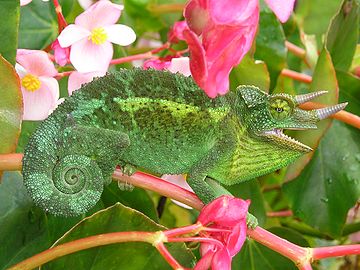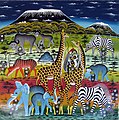Portal:Africa



Africa is the world's second-largest and second-most populous continent after Asia. At about 30.3 million km2 (11.7 million square miles) including adjacent islands, it covers 20% of Earth's land area and 6% of its total surface area. With nearly 1.4 billion people as of 2021, it accounts for about 18% of the world's human population. Africa's population is the youngest among all the continents; the median age in 2012 was 19.7, when the worldwide median age was 30.4. Based on 2024 projections, Africa's population will reach 3.8 billion people by 2099. Africa is the least wealthy inhabited continent per capita and second-least wealthy by total wealth, ahead of Oceania. Scholars have attributed this to different factors including geography, climate, corruption, colonialism, the Cold War, and neocolonialism. Despite this low concentration of wealth, recent economic expansion and a large and young population make Africa an important economic market in the broader global context. Africa has a large quantity of natural resources and food resources, including diamonds, sugar, salt, gold, iron, cobalt, uranium, copper, bauxite, silver, petroleum, natural gas, cocoa beans, and.
Africa straddles the equator and the prime meridian. It is the only continent to stretch from the northern temperate to the southern temperate zones. The majority of the continent and its countries are in the Northern Hemisphere, with a substantial portion and a number of countries in the Southern Hemisphere. Most of the continent lies in the tropics, except for a large part of Western Sahara, Algeria, Libya and Egypt, the northern tip of Mauritania, and the entire territories of Morocco and Tunisia, which in turn are located above the tropic of Cancer, in the northern temperate zone. In the other extreme of the continent, southern Namibia, southern Botswana, great parts of South Africa, the entire territories of Lesotho and Eswatini and the southern tips of Mozambique and Madagascar are located below the tropic of Capricorn, in the southern temperate zone.
Africa is highly biodiverse; it is the continent with the largest number of megafauna species, as it was least affected by the extinction of the Pleistocene megafauna. However, Africa is also heavily affected by a wide range of environmental issues, including desertification, deforestation, water scarcity, and pollution. These entrenched environmental concerns are expected to worsen as climate change impacts Africa. The UN Intergovernmental Panel on Climate Change has identified Africa as the continent most vulnerable to climate change.
The history of Africa is long, complex, and varied, and has often been under-appreciated by the global historical community. In African societies the oral word is revered, and they have generally recorded their history via oral tradition, which has led anthropologists to term them oral civilisations, contrasted with literate civilisations which pride the written word. During the colonial period, oral sources were deprecated by European historians, which gave them the impression Africa had no recorded history. African historiography became organized at the academic level in the mid-20th century, and saw a movement towards utilising oral sources in a multidisciplinary approach, culminating in the General History of Africa, edited by specialists from across the continent. (Full article...)
Selected article –
A part of Eastern Africa, the territory of what is known as Kenya has seen human habitation since the beginning of the Lower Paleolithic. The Bantu expansion from a West African centre of dispersal reached the area by the 1st millennium AD. With the borders of the modern state at the crossroads of the Bantu, Nilo-Saharan and Afro-Asiatic ethno-linguistic areas of Africa, Kenya is a multi-ethnic state. The Wanga Kingdom was formally established in the late 17th century. The Kingdom covered from the Jinja in Uganda to Naivasha in the East of Kenya. This is the first time the Wanga people and Luhya tribe were united and led by a centralized leader, a king, known as the Nabongo.
The European and Arab presence in Mombasa dates back to the Early Modern period, but European exploration of the interior began in the 19th century. The British Empire established the East Africa Protectorate in 1895, from 1928 known as the Kenya Colony. (Full article...)
Featured pictures –
Did you know (auto-generated) -

- ... that Jane C. Beck traveled to Virginia, West Africa, and England to research the family history of Daisy Turner for her 2015 book Daisy Turner's Kin: An African American Family Saga?
- ... that Roland Jefferson, the first African-American botanist to work at the U.S. National Arboretum, helped preserve the famous flowering cherry trees in Washington, D.C.?
- ... that Michigan defensive end Eyabi Okie, ranked number 3 in the 2018 college football recruiting class, changed his surname from "Anoma" to recognize his mother who lives in Africa?
- ... that Godwin Obasi has been described as "Africa's gift to the world of climate science"?
- ... that when the pastor of an African-American church bought the El Dorado, one newspaper wrote that "its occupants are white, and were white"?
- ... that the African Union has set up a space agency in a Space City?
Categories
Selected biography –
Lupita Amondi Nyong'o (US: /luːˈpiːtə ˈnjɔːŋoʊ/ loo-PEE-tə NYAWNG-oh, Swahili: [luˈpitɑ ˈɲɔŋɔ] ⓘ, Spanish: [luˈpita ˈɲoŋɡo]; born 1 March 1983) is an actress who has received various accolades, including an Academy Award and a Daytime Emmy Award, as well as nominations for two British Academy Film Awards, a Golden Globe Award and a Tony Award.
The daughter of Kenyan politician Peter Anyang' Nyong'o, she was born in Mexico City, where her father was teaching, and was raised in Kenya from the age of three. She attended college in the United States, earning a bachelor's degree in film and theatre studies from Hampshire College. She later began her career in Hollywood as a production assistant. In 2008, she made her acting debut with the short film East River and subsequently returned to Kenya to star in the television series Shuga (2009–2012). She then pursued a master's degree in acting from the Yale School of Drama. Soon after her graduation, she had her first feature film role as Patsey in Steve McQueen's biopic 12 Years a Slave (2013), for which she received critical acclaim and won the Academy Award for Best Supporting Actress. (Full article...)
Selected country –
 |
||

| ||
Libya (Arabic: ليبيا Lībiyā), officially the State of Libya, is a country in North Africa. Bordering the Mediterranean Sea to the north, Libya lies between Egypt to the east, Sudan to the southeast, Chad and Niger to the south, and Algeria and Tunisia to the west. With an area of almost 1.8 million square kilometres (700,000 sq mi), 90% of which is desert, Libya is the fourth largest country in Africa by area, and the seventeenth largest in the world. The capital, Tripoli, is also Libya's largest city. The three traditional parts of the country are Tripolitania, the Fezzan and Cyrenaica.
Libya was ruled by Muammar Gaddafi under the Great Socialist People's Libyan Arab Jamahiriya for 42 years before he was overthrown and killed by rebel forces during the 2011 Libyan civil war. From 2014 to 2020 the country endured a second civil war between rival governments based in Tripoli and Tobruk. The Libyan economy has historically depended primarily upon revenues from the oil sector, and under Gaddafi's government these oil revenues combined with a small population gave Libya one of the highest GDPs per person in Africa. (Read more...)
Selected city –

Thika (Gikuyu: [ˈθika]) is an industrial town and commerce hub in Kiambu County, Kenya, lying on the A2 road 42 kilometres (26 mi), northeast of Nairobi, near the confluence of the Thika and Chania Rivers. Although Thika town is administratively in Kiambu County, the greater Thika area comprising residential areas such as Bendor estate, Maporomoko, Thika Greens, Thika Golden Pearl, Bahati Ridge, and Thika Sports Club, among others, are within Murang'a County. Thika had a population of 279,429 as of the 2019 National Census and is growing rapidly. Its elevation is approximately 1,631 metres (5,351 ft).
Thika is home to Chania Falls and Fourteen Falls on the River Athi. Ol Donyo Sabuk National Park lies to the southeast. The town has a railway station with limited passenger service as only cargo trains operate, although there are plans to extend the proposed light rail system to Thika. (Full article...)
In the news
- 3 February 2025 – Sudanese civil war
- Battle of Khartoum
- 2025 Omdurman market attack
- The United Nations condemns the recent Rapid Support Forces attack on civilians in a market in Omdurman, Sudan, as a war crime. (Malaysia Sun)
- 2 February 2025 – War against the Islamic State
- War in Somalia
- American military intervention in Somalia, Islamic State insurgency in Puntland
- The Puntland military spokersperson claims that U.S. airstrikes against ISIL have killed 46 fighters in the Cal Miskaad Mountains, a remote area in northeastern region Bari, Somalia. (Hiiraan Online)
Updated: 15:05, 3 February 2025
General images -
Africa topics
More did you know –
- ...that members of the Senegalese rap group Daara J were hired by campaigners in the Senegalese election of 2000 to edit their speeches?
- ...that Senegalese hip hop group Positive Black Soul's name abbreviation, PBS, is a play on that of the Parti Démocratique Sénégalais, PDS?
- ...that Mamadou Diabaté, a Malian kora player, was nominated for a Grammy Award in 2005, but lost to his cousin Toumani Diabaté?
- ...that, in November 2007, The Sowetan published an article which erroneously claimed that South African political activist Dan Mokonyane had died?
Related portals
Major Religions in Africa
North Africa
West Africa
Central Africa
East Africa
Southern Africa
Associated Wikimedia
The following Wikimedia Foundation sister projects provide more on this subject:
-
Commons
Free media repository -
Wikibooks
Free textbooks and manuals -
Wikidata
Free knowledge base -
Wikinews
Free-content news -
Wikiquote
Collection of quotations -
Wikisource
Free-content library -
Wikispecies
Directory of species -
Wikiversity
Free learning tools -
Wikivoyage
Free travel guide -
Wiktionary
Dictionary and thesaurus























































































